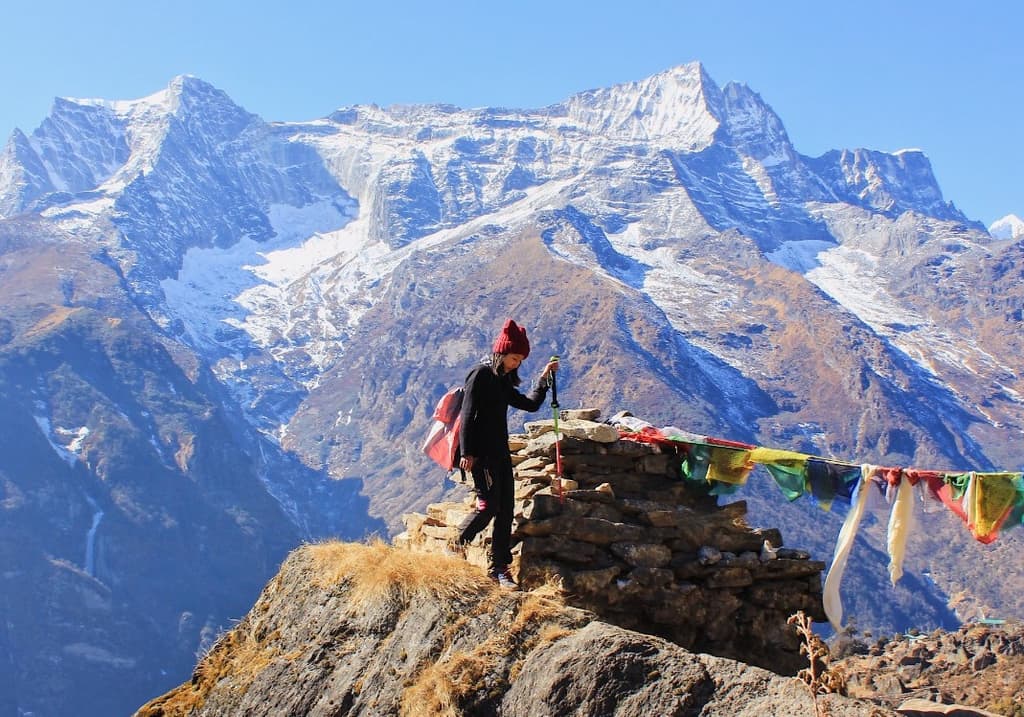Nepal, known as the land of the Himalayas, is a paradise for mountain enthusiasts and climbers from around the world. The country boasts a multitude of awe-inspiring peaks, including some of the world's highest mountains. Peak climbing in Nepal provides an exciting and challenging adventure, allowing climbers to experience the thrill of reaching lofty summits and witnessing breathtaking panoramic views.
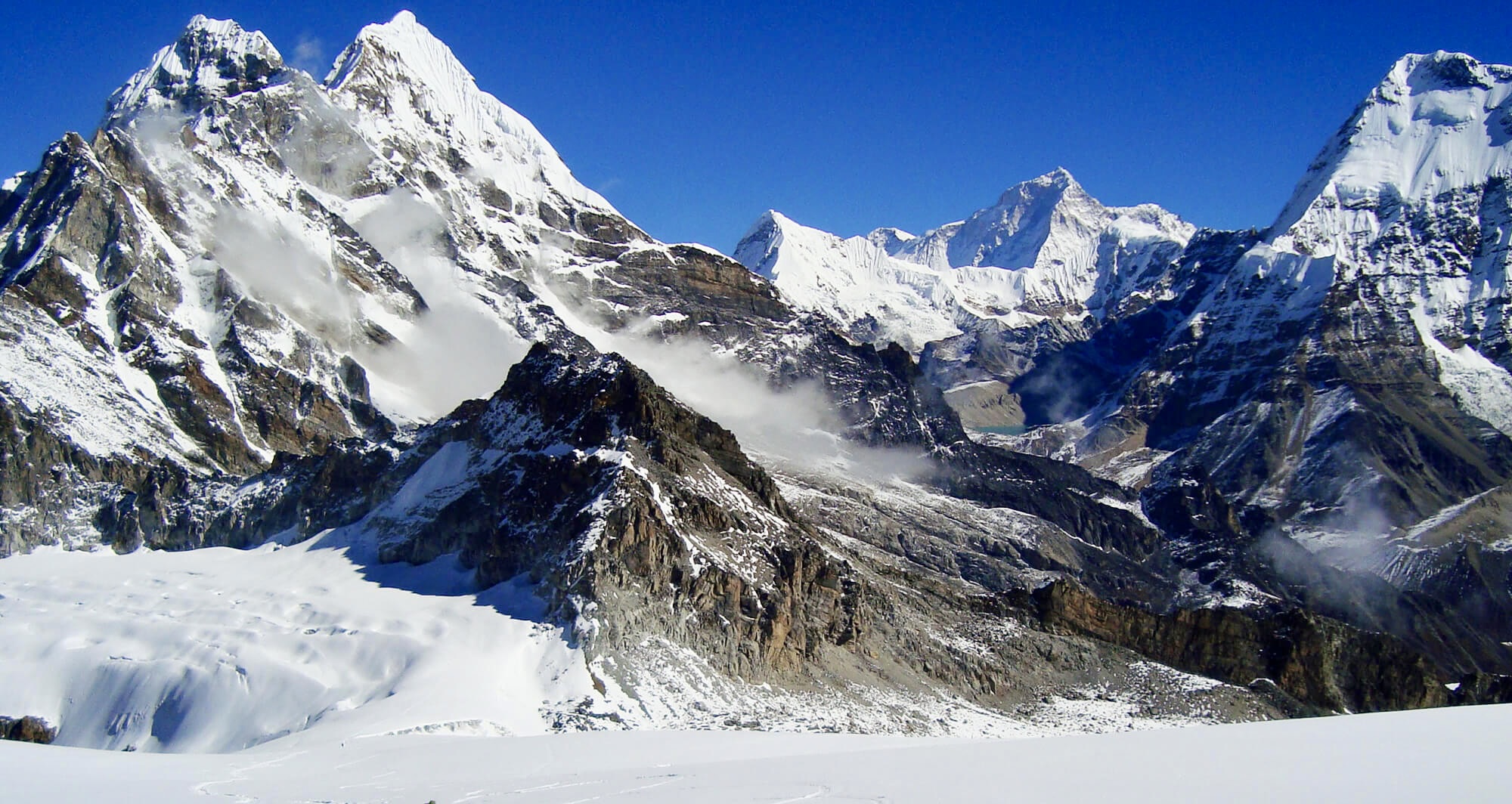
It's crucial to take into account as many variables as possible when organizing a peak-climbing excursion in Nepal, such as the climate and weather. The temperature can get very low at higher altitudes, especially at night. It's important to come equipped with the right gear and apparel to survive cold weather. In Nepal, spring and fall are often the finest seasons for peak climbing. The temperatures are reasonable, and the weather is remarkably consistent.
It is important to choose a peak that is suitable for your level of experience and physical fitness. you'll need to invest in the right gear and safety precautions. Make sure your guide has experience and is educated about the area and the terrain. This will make the ascent safer and more successful.
Top 5 five peak climbing and Expeditions for Beginners in Nepal
Island Peak (6,189m)
Located in the Everest region, Island Peak is one of the most popular peaks for beginners in Nepal. It offers a moderate technical challenge and requires basic mountaineering skills. The climb provides stunning views of the surrounding Himalayan peaks.
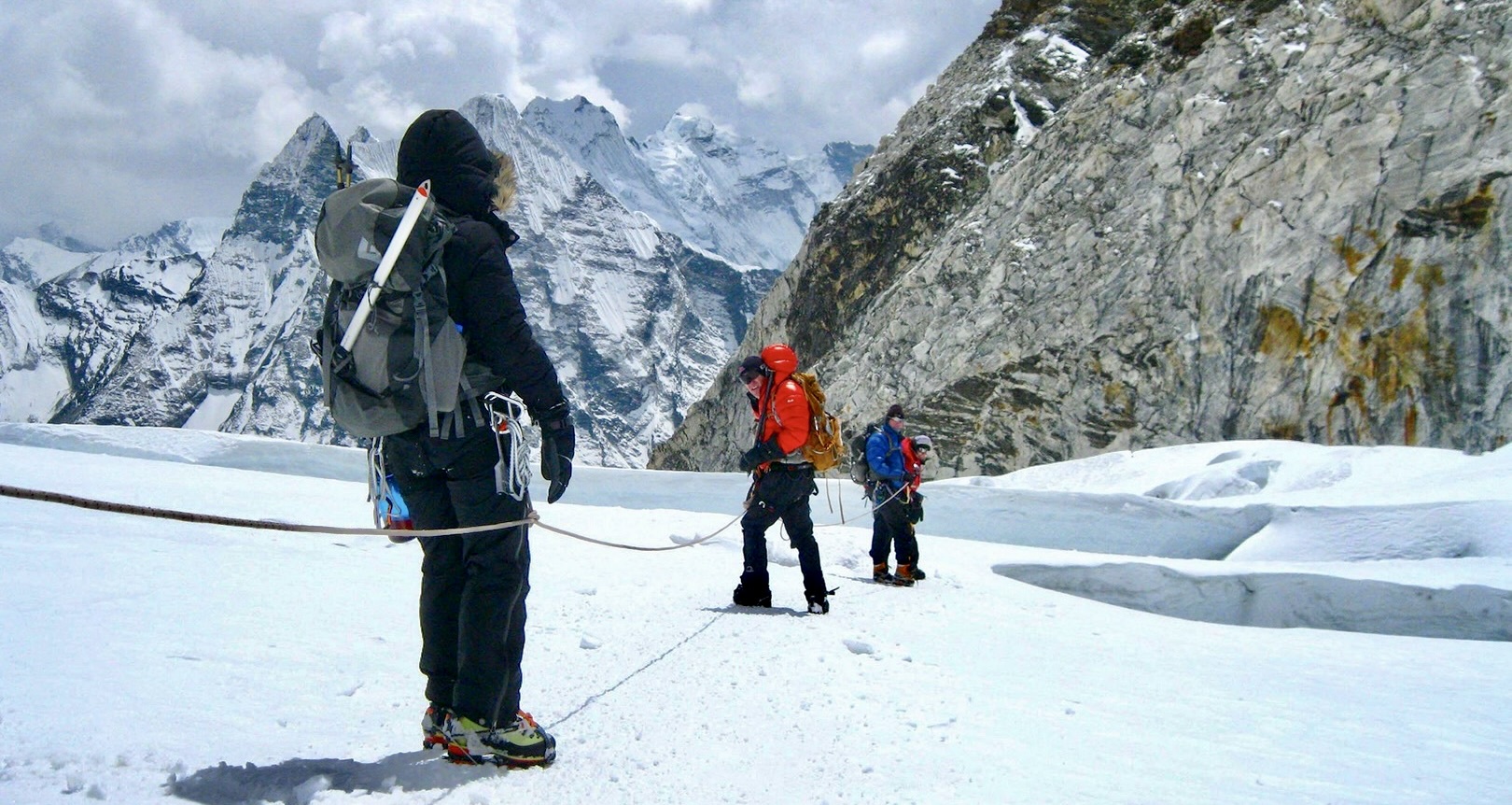
Here are some key details about Island Peak
- Elevation: Island Peak stands at an altitude of 6,189 meters (20,305 feet) above sea level, making it one of the more accessible peaks in the region.
- Location: It is situated in the Sagarmatha National Park in the Khumbu region of Nepal. The starting point for Island Peak is usually the village of Chhukung.
- Difficulty Level: Island Peak is classified as a moderate to challenging climb. While it doesn't require extensive technical mountaineering skills, a good level of physical fitness, prior trekking experience, and basic mountaineering techniques are necessary. Climbers should be prepared for steep ascents, exposed ridges, and potential snow and ice conditions.
- Climbing Route: Imja Tse, or the Island Peak climbing route, is situated in Nepal's Everest region. The expedition starts with a flight from Kathmandu to Lukla, a tiny town near Mount Everest and the gateway to the Khumbu Valley. From Lukla, trekkers travel on foot to Namche Bazaar, a bustling Sherpa town that acts as an acclimatization stop. Climbers often take a day off to continue acclimatizing in the village of Dingboche, which is reached after passing through picturesque Sherpa settlements and breathtaking landscapes. From Dingboche, climbers proceed to Chhukung, a little town in the Imja Valley. This provides the framework for Island Peak.
From Chhukung, climbers make the journey to Island Peak Base Camp. The hike offers stunning views of the local peaks and glaciers. After reaching the base camp, climbers ascend to the Island Peak High Camp. The climb entails traversing glaciers, climbing up steep snow slopes, and potentially making use of ropes, crampons, and ice axes. You have to cross rugged terrain to do this, and occasionally you have to utilize fixed ropes for safety. - Scenic Views: From the summit of Island Peak, climbers are rewarded with breathtaking panoramic views of several towering Himalayan peaks, including Mount Everest (8,848 meters/29,029 feet), Lhotse (8,516 meters/27,940 feet), Nuptse (7,861 meters/25,791 feet), and several others.
- Duration: The typical duration for an Island Peak climbing expedition is around 18-20 days, which includes acclimatization days and the trek to and from the peak. The itinerary usually involves trekking through the beautiful Khumbu Valley, passing through Namche Bazaar and Tengboche.
- Permits: Climbing Island Peak requires obtaining a climbing permit from the Nepal Mountaineering Association (NMA) as well as the necessary trekking permits for the Everest region. A Sagarmatha National Park Entry Permit is required for all climbers entering the Everest region, which includes Island Peak. This license supports the national park's preservation and upkeep while granting access to it. Climbers need to obtain a Khumbu Rural Municipality Permit in addition to the national park permit. The infrastructure and development in the Khumbu region are supported by this permit charge. It is available in Monjo or Lukla.
Mera Peak (6,476 m)
Situated in the remote Hinku Valley, Mera Peak is another excellent choice for beginner climbers. It is the highest trekking peak in Nepal, standing at 6,476 meters (21,247 feet). The ascent involves some crevasses and a gradual slope, but it doesn't require advanced mountaineering experience.
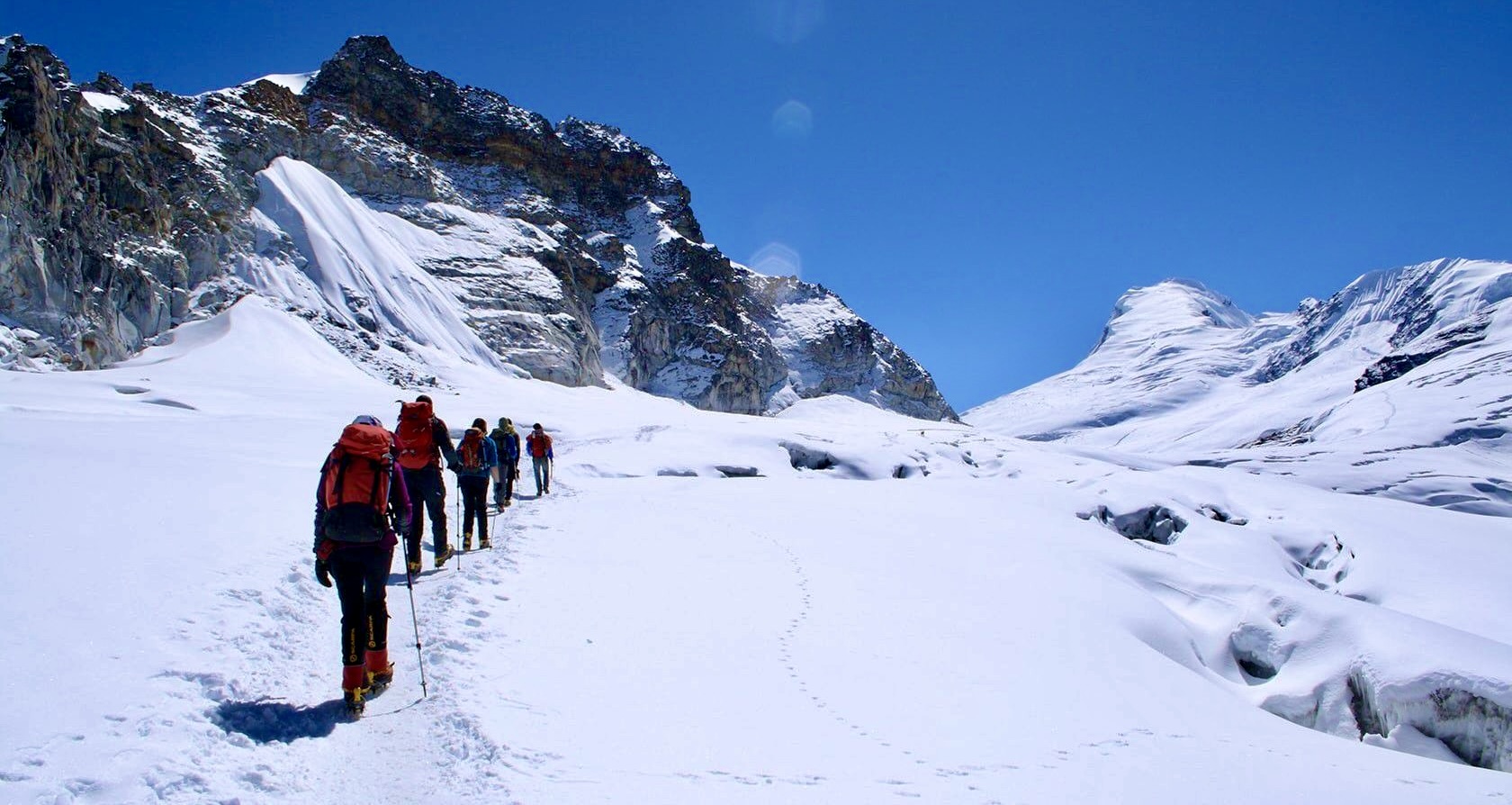
Here is some information about Mera Peak
- Elevation: Mera Peak stands at an altitude of 6,476 meters (21,247 feet) above sea level, making it the highest trekking peak in Nepal. Despite its impressive height, Mera Peak is considered a non-technical climb suitable for climbers with basic mountaineering skills and good physical fitness.
- Location: Mera Peak is situated in the remote Hinku Valley of the Everest region, northeast of Kathmandu. The starting point for the climb is typically Lukla, which is accessed by a short flight from Kathmandu. From Lukla, trekkers make their way through picturesque Sherpa villages, dense forests, and high alpine landscapes to reach the base camp of Mera Peak.
- Climbing Difficulty: While Mera Peak is a non-technical climb, it does involve some challenging aspects. Climbers should be prepared for long days of trekking, steep ascents, and the use of basic mountaineering equipment such as crampons and ice axes. Some sections may require fixed ropes and basic glacier travel skills. Prior trekking experience is beneficial, but technical climbing experience is not mandatory.
- Climbing Route: Multiple high camps are typically set up along the conventional climbing route for Mera Peak in order to facilitate acclimatization and ease the ascent. The tour begins with a flight from Kathmandu to Lukla, which serves as the gateway to the Khumbu region. The hike involves several suspension bridge crossings and a descent.
After going through more substantial forests, terraced farms, and traditional Sherpa settlements, Panggom is eventually reached. Rhododendron trees and lovely Sherpa settlements are on the way to Gnashing Dingma. Trekkers cross a suspension bridge across the Hinku River to go to Chhatra Khola. Here is the last village in the remote Hinku Valley.
From Chhatra Khola, the route continues across the Hinku Valley to the west. The trail goes to Tangnang (also known as Thagnag), which is located at a height of about 4,350 meters (14,272 ft). As the landscape transforms to alpine flora, hikers can view the Charpate Himal and Kyashar. From Tangnang, hikers proceed to Khare, the Mera Peak base camp. This section involves a challenging climb and lateral glacier crossing on the Dig Glacier.
A day of rest is frequently scheduled for this reason in Khare. Short hikes allow climbers to investigate their surroundings and master the basics of climbing. From Khare, climbers ascend to Mera La Pass (5,415 meters; 17,766 ft). The terrain can be a little rocky, and using fixed ropes to traverse crevasses is necessary. Climbers proceed to the 5,800-metre (19,029-foot) high camp at Mera Peak from Mera La. The terrain becomes increasingly difficult and steeper as it climbs. - Scenic Views: Reaching the summit of Mera Peak offers breathtaking views of several majestic Himalayan peaks, including Everest (8,848 meters/29,029 feet), Lhotse (8,516 meters/27,940 feet), Makalu (8,481 meters/27,825 feet), and Kanchenjunga (8,586 meters/28,169 feet), among others. The panoramic vistas of the surrounding valleys, glaciers, and mountain ranges make the climb a truly rewarding experience.
- Duration: The duration of a Mera Peak climbing expedition typically ranges from 15 to 20 days, depending on the itinerary and acclimatization schedule. This includes trekking to and from the peak, allowing for proper adjustment to high altitude and ensuring a safer climb.
- Permits: Climbing Mera Peak requires obtaining climbing permits from the Nepal Mountaineering Association (NMA), as well as the necessary trekking permits for the Everest region. Climbers need a Makalu Barun National Park Entry Permit in order to enter the park. The management and conservation of the park are aided by this permit. Climbers must also get a Sagarmatha National Park Entry Permit because the typical route for ascending Mera Peak frequently entails walking through this national park (in the Everest region). The park's conservation efforts are supported by this permit, which grants entry. It is available in Kathmandu, as well as at the Monjo or Jorsalle park entrances. An additional permit from the Khumbu Pasang Lhamu Rural Municipality is required for climbers. The development is funded by this license fee.
Lobuche East Peak (6,119m)
Found in the Everest region, Lobuche East Peak offers an exciting climb for novice mountaineers. The route involves a mixture of scrambling, snow climbing, and some steep sections. The summit provides breathtaking panoramic views of Everest, Lhotse, Nuptse, and other nearby peaks.
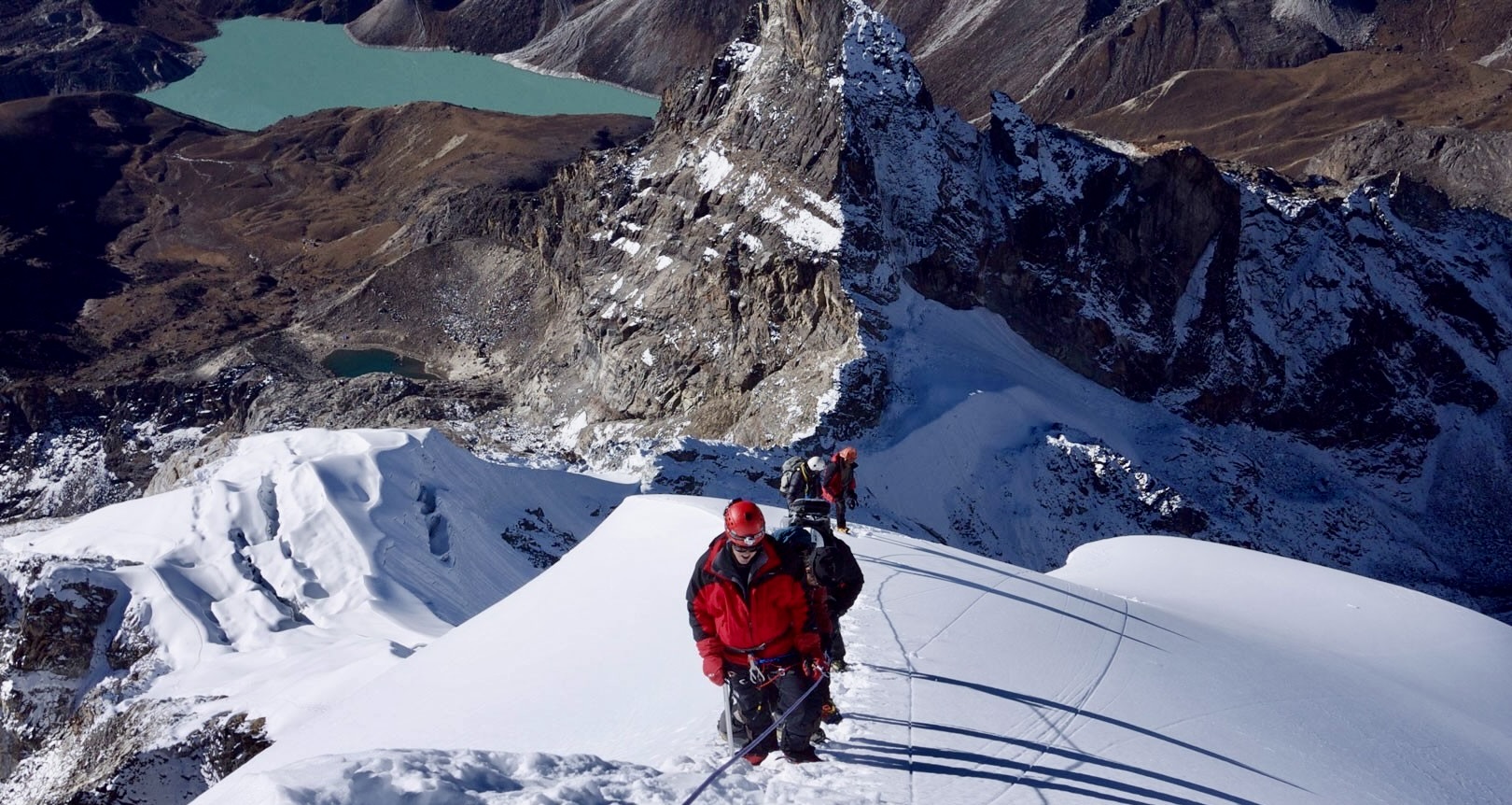
Here is some information about Lobuche East Peak
- Elevation: Lobuche East Peak stands at an altitude of 6,119 meters (20,075 feet) above sea level. It is one of the prominent peaks in the Khumbu Valley and offers stunning views of the Everest region.
- Location: Lobuche East Peak is situated in the Sagarmatha National Park, in close proximity to the famous Everest Base Camp trekking route. The starting point for Lobuche East is typically the village of Lobuche, which is reached after a scenic trek from Lukla.
- Climbing Difficulty: Lobuche East Peak is considered a technically challenging climb, requiring prior mountaineering experience and good physical fitness. The ascent involves steep slopes, rocky terrain, and some sections of snow and ice. Basic mountaineering skills, including the use of crampons, ice axes, and rope techniques, are necessary.
- Climbing Route: Lobuche East can be climbed using a variety of routes, the Southeast Ridge being the most popular. The trip officially begins on the flight from Kathmandu to Lukla, which serves as the gateway to the Khumbu region. From Lukla, trekkers travel on foot to Namche Bazaar, a bustling Sherpa town that acts as a stopover for acclimatization.
The journey continues through amazing forests and Sherpa settlements to reach Tengboche. Tengboche is the location of a historic monastery in addition to providing breathtaking views of Everest and its neighboring peaks. From Tengboche, hikers continue to Dingboche, a town in the Imja Valley. This popular acclimatization spot offers panoramic views of the surrounding mountains. Visitors can travel the path to reach Lobuche, a small town at the base of Lobuche East.
The Lobuche East Base Camp, which is located on the glacier's moraine, is reached by climbers ascending from Lobuche. Along the ascent, views of Nuptse, Pumori, and other nearby peaks are possible. A rest day is typically scheduled at base camp for acclimatization and final climb-related preparations. Climbers can participate in basic mountaineering training as well. From the base camp, climbers ascend to the Lobuche East High Camp. There are some difficult sections of the path, including a glacier crossing. - Scenic Views: Reaching the summit of Lobuche East offers breathtaking panoramic views of the Everest region, including iconic peaks like Mount Everest, Lhotse, Nuptse, Ama Dablam, and many others. The surrounding landscapes feature stunning glaciers, deep valleys, and dramatic Himalayan vistas.
- Duration: The duration of a Lobuche East climbing expedition typically ranges from 18 to 20 days, including trekking to and from the peak. This time frame allows for proper acclimatization and ensures a safer climb.
- Permits: Climbing Lobuche East Peak requires obtaining climbing permits from the Nepal Mountaineering Association (NMA), as well as the necessary trekking permits for the Everest region.
Pisang Peak (6,091m)
Situated in the Annapurna region, Pisang Peak is a popular choice for beginners. It requires basic climbing skills and offers a relatively straightforward ascent. The climb rewards you with spectacular views of Annapurna II, III, IV, Gangapurna, and other peaks in the region.
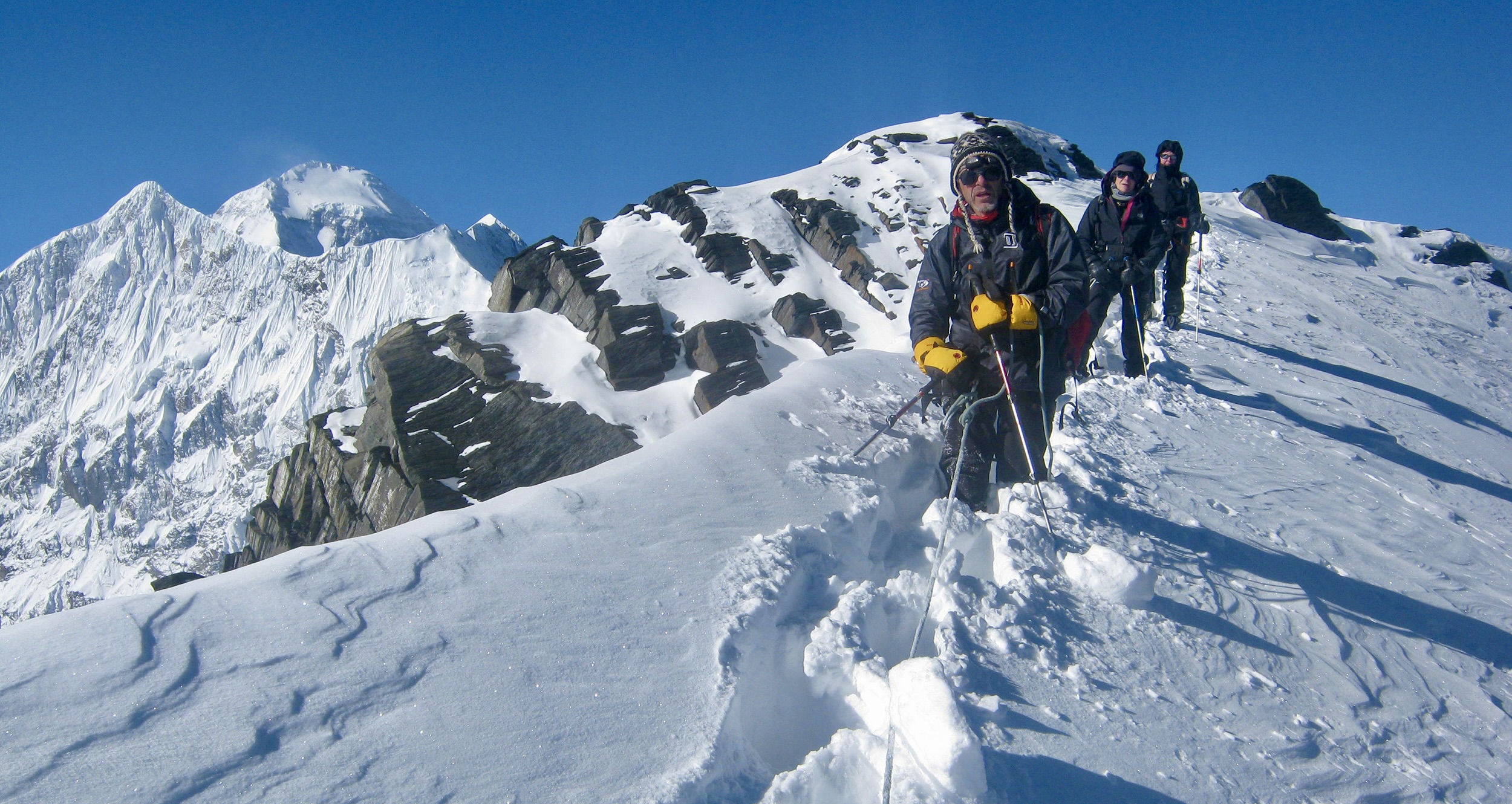
Here is more information about Pisang Peak
- Elevation: Pisang Peak stands at an altitude of 6,091 meters (19,980 feet) above sea level. It is one of the lower trekking peaks in Nepal, making it accessible to climbers with moderate mountaineering experience.
- Location: Pisang Peak is situated in the Manang Valley of the Annapurna region, northwest of Kathmandu. The journey to Pisang Peak typically starts with a scenic drive from Kathmandu to the town of Besisahar, followed by a trek through picturesque villages, terraced fields, and lush forests.
- Climbing Difficulty: Pisang Peak is considered a moderate climb, suitable for climbers with basic mountaineering skills and a good level of physical fitness. While it does not require extensive technical expertise, climbers should be prepared for some challenging aspects, including steep ascents, snow slopes, and the use of basic mountaineering equipment such as crampons and ice axes.
- Climbing Route: The village of Pisang serves as the starting point for the standard climbing route to Pisang Peak, where climbers set up a base camp. The first stage of the journey is from Kathmandu to Besisahar, the starting point of the Annapurna Circuit trek. From Besisahar, trekkers rise to Dharapani by way of picturesque villages and terraced fields. This section is a part of the well-known Annapurna Circuit path.
Before reaching Chame, the administrative hub for the Manang district, the journey continues through forests and numerous suspension bridges. From Chame, hikers proceed to Pisang, a charming village at the base of Pisang Peak. This region offers stunning views of Annapurna II and other peaks.
From Pisang, climbers ascend to the Pisang Peak Base Camp. Hikers will rise through alpine forests and cross glacial moraines on their journey. Climbers move from the Pisang Peak's base camp to the high camp. Climbers move from the base camp to the Pisang Peak High Camp. You have to navigate steep, icy hills throughout this level using ropes and crampons. opens, using crampons and ropes. - Scenic Views: Reaching the summit of Pisang Peak rewards climbers with breathtaking views of the surrounding Himalayan peaks, including Annapurna II, Annapurna III, Annapurna IV, Gangapurna, and others. The landscapes feature stunning valleys, deep gorges, and diverse flora and fauna.
- Duration: The duration of a Pisang Peak climbing expedition typically ranges from 16 to 18 days, including trekking to and from the peak. This time frame allows for proper acclimatization and ensures a safe ascent.
- Permits: Climbing Pisang Peak requires obtaining climbing permits from the Nepal Mountaineering Association (NMA), as well as the necessary trekking permits for the Annapurna region.
Yala Peak(5,700m)
Yala Peak is a popular trekking peak located in the Langtang region of Nepal. Standing at an elevation of 5,732 meters (18,806 feet), it offers a moderate technical climb and is a great choice for climbers seeking a challenging but accessible peak. Here is some more information about Yala Peak:
- Elevation: Yala Peak stands at an altitude of 5,520 meters (18,110 feet) above sea level.
- Location: It is situated in the Langtang region of Nepal, north of Kathmandu, near the border of Tibet.
- Difficulty: Yala Peak is considered a relatively easy trekking peak, suitable for beginner climbers with basic mountaineering skills. However, it still requires a good level of physical fitness and acclimatization to high altitudes.
- Climbing Route: A wonderful village in the Langtang Valley called Kyanjin Gompa serves as the starting point for the conventional climbing path to Yala Peak. Drive from Kathmandu to Syabrubesi, where the Langtang Valley hike begins, to begin the expedition. Trekkers leave Syabrubesi and go along the Langtang River, passing through agricultural villages and forested areas. The route to Langtang Village continues through breathtaking bamboo and rhododendron trees. This common Sherpa community offers a break from the altitude to take a rest.
Trekkers can hike from Langtang Village to Kyanjin Gompa, a well-known Buddhist monastery and the main attraction of the Langtang region. This section crosses yak pastures and provides stunning views of the mountains. At Kyanjin Gompa, a free day is typically scheduled for acclimatization and local exploration.
From Kyanjin Gompa, climbers ascend to the Yala Peak Base Camp. Views of mountains and glaciers are provided as the road winds through rugged and glacial terrain. Climbers move from the base camp to the Yala Peak High Camp. Using crampons, ice axes, and ropes, one must climb steep, snowy hills in this phase. - Scenic Views: From the summit of Yala Peak, climbers are rewarded with breathtaking panoramic views of the surrounding peaks, including Langtang Lirung (7,227 meters), Dorje Lakpa (6,966 meters), Shishapangma (8,027 meters), and other snow-capped mountains in the region.
- Permit Requirements: To climb Yala Peak, you need to obtain the necessary permits, including the Langtang National Park entry permit and the climbing permit from the Nepal Mountaineering Association (NMA).
- Duration: The duration of the Yala Peak climb varies depending on the itinerary, but it usually takes around 10-14 days, including trekking to Kyanjin Gompa, acclimatization, and the ascent to the summit.
Best time for Climbing and Expedition
The best time for climbing and expeditions in Nepal depends on the specific mountain or region you plan to explore. However, the general best seasons are:
Spring (pre-monsoon): March to May
During spring, the weather is generally stable, with clear skies and mild temperatures. This period offers excellent climbing conditions and good visibility. It is the most popular season for climbing expeditions in Nepal.
Autumn (post-monsoon): September to November
Autumn is another favorable season for climbing and expeditions. The weather is generally dry and stable, with clear skies and mild temperatures. The post-monsoon period offers breathtaking views, and the trails are less crowded compared to the spring season.
These two seasons provide the best weather conditions and visibility for climbing in Nepal. However, it's essential to check the specific climbing conditions and consult with local authorities or experienced climbers before planning your expedition, as weather patterns can vary from year to year.
Cost for Climbing and Expedition in Nepal
The cost for climbing and expeditions in Nepal can vary depending on various factors, including the mountain you choose, the duration of the expedition, the services included, and the number of climbers in your group. Here are some general cost considerations:
- Climbing Permit: The cost of climbing permits varies depending on the peak you intend to climb. For popular peaks like Mount Everest, the permit fees can be quite high, ranging from several thousand to tens of thousands of dollars. Permits for other peaks may have lower fees.
- Guide and Sherpa Services: Hiring a guide and Sherpa is highly recommended for climbing expeditions, especially for beginners. The cost of their services can vary based on their experience, expertise, and the duration of the expedition. This cost typically includes their wages, food, accommodation, and equipment.
- Equipment Rental: If you don't have your own climbing gear, you may need to rent equipment such as climbing boots, crampons, ice axes, harnesses, and tents. The rental fees depend on the duration and the specific gear you require.
- Accommodation and Meals: During the expedition, you'll need accommodations and meals at base camps, higher camps, and sometimes during the trekking portion of the journey. The cost varies based on the location and the level of comfort provided.
- Logistics and Transportation: This includes the cost of transportation from Kathmandu to the starting point of the trek or climbs, as well as the cost of porters or pack animals to carry equipment and supplies.
- Insurance: Travel and medical insurance are essential for climbing expeditions. The cost of insurance can vary based on coverage and the duration of your expedition.
- Miscellaneous Expenses: Other expenses may include permits for trekking in conservation areas, visa fees, tips for guides and support staff, and any additional services or equipment you may require.
It's important to note that the cost of climbing and expeditions in Nepal can be significant. It is advisable to budget accordingly and plan in advance.
Important notes on climbing and expeditions in Nepal
When planning a climbing and expedition in Nepal, there are several important notes to keep in mind:
- Physical Fitness and Training: Climbing in Nepal requires a good level of physical fitness. Prioritize physical training, including cardiovascular exercises, strength training, and endurance-building activities. Acclimatization and altitude training are also crucial.
- Experience and Skills: While some peaks in Nepal are suitable for beginners, it is essential to have prior trekking and mountaineering experience. Familiarize yourself with basic mountaineering techniques, including the use of crampons, ice axes, and rope skills. Consider taking a mountaineering course or hiring experienced guides.
- Acclimatization: Proper acclimatization is essential to prevent altitude-related illnesses. Ascend slowly, take rest days, and follow the recommended altitude gain guidelines. Be aware of the symptoms of altitude sickness and prioritize your health and safety.
- Weather Conditions: Nepal's weather can be unpredictable, especially at high altitudes. Stay informed about the weather forecasts and be prepared for sudden changes. Plan your climbs during the recommended seasons for the specific mountain you intend to climb.
- Permits and Regulations: Obtain the necessary permits for climbing and trekking in Nepal. This includes climbing permits, trekking permits, and TIMS cards. Follow the regulations set by the Department of Tourism and respect the local culture and environment.
- Hiring Guides and Sherpas: Consider hiring experienced guides and Sherpas for your expedition. They have extensive knowledge of the mountains, can provide support and assistance, and enhance your safety during the climb.
- Safety Measures: Prioritize safety at all times. Be equipped with appropriate gear, including climbing equipment, clothing, and personal safety items. Follow safety protocols, listen to your guides' instructions, and be prepared for emergencies.
- Leave No Trace: Practice responsible and sustainable mountaineering. Respect the environment, carry your trash, and follow the principles of Leave No Trace. Minimize your impact on fragile mountain ecosystems.
- Travel Insurance: Obtain comprehensive travel and medical insurance that covers mountaineering and emergency evacuation in Nepal. Ensure your insurance policy specifically covers high-altitude mountaineering.
- Cultural Sensitivity: Respect the local culture, traditions, and customs of the communities you encounter during your climb. Dress modestly, seek permission before entering sacred sites, and engage with the local people in a respectful manner.
Remember that climbing and expeditions in Nepal can be physically and mentally demanding. Proper preparation, training, and a realistic assessment of your capabilities are crucial. Prioritize safety, enjoy the journey, and cherish the unique experience of climbing in the majestic mountains of Nepal.
High altitude sickness during climbing and expedition in Nepal
High altitude sickness, also known as acute mountain sickness (AMS), is a common concern during climbing and expeditions in Nepal due to the high elevations involved. Here are some important points to understand about AMS:
- Causes: AMS occurs when the body is exposed to reduced oxygen levels at high altitudes, typically above 2,500 meters (8,000 feet). The rapid ascent without proper acclimatization is the primary cause of AMS.
- Symptoms: Symptoms of AMS can vary from mild to severe and typically appear within the first 24-48 hours of reaching higher altitudes. Common symptoms include headache, nausea, dizziness, fatigue, loss of appetite, difficulty sleeping, and shortness of breath. If left untreated or if the condition worsens, it can lead to more severe forms of altitude sickness, such as high altitude pulmonary edema (HAPE) or high altitude cerebral edema (HACE), which require immediate medical attention.
- Prevention and Acclimatization: The best way to prevent AMS is through proper acclimatization. This involves gradually ascending to higher altitudes, taking regular rest days to allow your body to adjust, and hydrating adequately. Slow and steady climbs, following recommended altitude gain guidelines, can significantly reduce the risk of AMS.
- Hydration and Nutrition: Drink plenty of fluids, preferably water, to stay hydrated at high altitudes. Avoid alcohol and caffeine as they can contribute to dehydration. Maintain a balanced diet and ensure you are consuming enough calories to sustain your energy levels.
- Medication: Some climbers may consider taking medications such as acetazolamide (Diamox) to help prevent or alleviate AMS symptoms. However, it is essential to consult with a healthcare professional before using any medication and to be aware of potential side effects.
- Recognizing Symptoms and Descending: It is crucial to monitor your own and your team members' symptoms closely. If you or someone in your group experiences severe symptoms of AMS or shows signs of HAPE or HACE, it is essential to descend to a lower altitude immediately and seek medical attention.
- Fitness and Preparation: Being physically fit and well-prepared can help reduce the risk of AMS. Engage in regular physical exercise and cardio workouts to improve your cardiovascular endurance and lung capacity.
- Education and Awareness: Educate yourself about AMS and other altitude-related illnesses before your climb. Be aware of the symptoms, risk factors, and appropriate actions to take if symptoms occur.
It's important to note that AMS can affect anyone, regardless of age, fitness level, or previous climbing experience. Prioritizing proper acclimatization, staying hydrated, and monitoring your body's response to the altitude are crucial for a safe and enjoyable climbing experience in Nepal.
Accommodations during climbing and expeditions in Nepal
During climbing and expeditions in Nepal, accommodations can vary depending on the specific mountain or region you are exploring. Here are some common types of accommodations you can expect:
- Teahouses/Lodges: Teahouses or lodges are commonly found along popular trekking routes and at lower elevations. These are basic guesthouses that offer rooms with a bed, shared bathrooms (sometimes with hot water showers), and communal dining areas. Teahouses provide meals, including local and international dishes, and are a convenient and social accommodation option.
- Base Camps: Base camps are established at the starting point for climbing expeditions on higher peaks. These camps usually have basic infrastructure, including tents for accommodation and dining facilities. Base camps provide a comfortable resting place before climbers begin their ascent.
- High Camps: For peaks that require multiple days of climbing, high camps are established at intermediate altitudes. High camps provide temporary accommodation in the form of tents, where climbers rest and acclimatize before making the final push for the summit.
- Tented Camps: During climbing expeditions, especially for more remote or less frequented peaks, climbers may set up their own tented camps at various points along the route. These camps serve as temporary shelters and provide protection from the elements.
- Climbing Huts: In some areas, climbing huts or mountain huts are available for climbers. These huts are more common in the Annapurna and Langtang regions. They offer basic accommodation with bunk beds, shared facilities, and limited amenities.
It's important to note that as you ascend to higher altitudes, the availability of accommodations becomes more limited, and the facilities may become more basic. It's advisable to carry a good-quality sleeping bag and other necessary camping gear for higher camps or more remote areas.
During peak climbing seasons, popular base camps and teahouses can become crowded, so it's recommended to make advance reservations, especially for larger groups. Additionally, be prepared for shared accommodations and limited amenities, as the focus during climbing expeditions is on safety, functionality, and minimal environmental impact.
Foods on climbing and expeditions in Nepal
During climbing and expeditions in Nepal, the food options can vary depending on the type of accommodation and the region you are in. Here are some common foods you can expect during your climb:
- Dal Bhat: Dal Bhat is the staple dish of Nepal and is widely available in teahouses and lodges. It consists of steamed rice (bhat) served with lentil soup (dal), vegetable curry (tarkari), pickles (achar), and sometimes a small portion of meat or fish. It provides a good source of carbohydrates, protein, and essential nutrients.
- Momos: Momos are popular dumplings in Nepal. They are filled with meat (such as chicken, buffalo, or yak) or vegetables and served with a spicy dipping sauce. Momos are a favorite among trekkers and climbers for their taste and convenience.
- Noodles: Various noodle dishes like Chow Mein (stir-fried noodles) and Thukpa (noodle soup) are commonly available in teahouses and lodges. They are often prepared with vegetables, eggs, and occasionally meat.
- Energy Bars and Snacks: Many climbers carry energy bars, granola bars, nuts, dried fruits, and other snacks to provide quick and convenient sources of energy during the climb. These can be purchased in Kathmandu or brought from home.
- Soups: Hot soups like tomato soup, vegetable soup, or chicken soup are popular choices to warm up and replenish fluids during colder days at higher altitudes.
- Tibetan Bread: Tibetan bread, known as "roti" or "chapati," is a type of flatbread that is often served with butter, jam, or honey. It is a simple yet filling option for breakfast or as a snack.
- Porridge/Oatmeal: Warm porridge or oatmeal is a common breakfast option for climbers. It provides a good source of energy and can be customized with additions like fruits, nuts, or honey.
- Tea and Hot Drinks: Tea is a staple in Nepalese culture, and various types of tea are available, including black tea, milk tea (chai), and herbal tea. Hot drinks like hot chocolate and coffee are also commonly available.
It's important to note that the availability and variety of food options can become more limited as you climb higher or venture into more remote areas. The teahouses and lodges may have fixed menus, and it's advisable to expect simpler meals with a focus on providing sustenance and energy for the climb.
Nepal has a variety of peaks that are suitable for beginners looking to begin their mountaineering career. Accessible and moderately challenging climbing options are available on peaks like Island Peak, Mera Peak, Pisang Peak, and Yala Peak. While taking in the breathtaking Himalayan views offered by these peaks, climbers can fully appreciate the natural beauty of Nepal's alpine environments. Joining a guided expedition with experienced guides and the necessary training is highly recommended for a safe and enjoyable climbing experience. The beginner-friendly peaks of Nepal are a great location to start for intrepid climbers eager to learn about climbing in one of the most spectacular mountain ranges on earth.
Frequently Asked Questions in Nepal for Climbing and Expedition for Beginners in Nepal
Q: What are some popular mountains for beginners to climb in Nepal?
A: Some popular mountains for beginners to climb in Nepal include:
Island Peak (Imja Tse): Located in the Everest region, it offers a relatively moderate climb and stunning views.
Mera Peak: Situated in the Khumbu region, it is considered one of the highest trekking peaks and provides an excellent introduction to mountaineering.
Lobuche East: Another peak in the Everest region, it offers a relatively challenging climb but is suitable for beginners with some prior trekking experience.
Yala Peak: Found in the Langtang region, it is a non-technical peak and a great choice for beginners.
Pisang Peak: Situated in the Annapurna region, it provides a moderate climb and rewards climbers with breathtaking views.
Q: What are the essential permits required for climbing expeditions in Nepal?
A: The main permits required for climbing expeditions in Nepal are as follows:
Climbing Permit: This is a permit specific to the mountain you intend to climb and is issued by the Department of Tourism.
Trekking Permit: If your climb involves trekking to the base camp, you will need a trekking permit for the respective region, such as the Everest or Annapurna Conservation Area Permit.
TIMS Card: The Trekkers' Information Management System (TIMS) card is required for trekking in certain regions, such as Everest and Annapurna.
Q: Are there any age restrictions for climbing mountains in Nepal?
A: Yes, there are age restrictions for climbing mountains in Nepal. The minimum age requirement for climbing peaks below 5,800 meters is generally 16 years. For peaks above 5,800 meters, climbers need to be at least 18 years old. However, these age restrictions may vary depending on the specific peak and the regulations set by the Department of Tourism.
Q: Do I need prior climbing experience to attempt a beginner's climb in Nepal?
A: While prior climbing experience is not always mandatory for beginner climbs in Nepal, it is highly recommended. You should have a good level of physical fitness and some experience with high-altitude trekking. Familiarity with basic mountaineering techniques, such as using crampons and ice axes, is also beneficial. It is advisable to undergo a comprehensive training program or hire an experienced guide to ensure safety and increase your chances of success.
Q: What is the best time of year for beginners to attempt climbing in Nepal?
A: The best time for beginners to attempt climbing in Nepal is generally during the pre-monsoon (spring) and post-monsoon (autumn) seasons. The months of April to May and September to November offer the most favorable weather conditions, with stable weather, clear skies, and moderate temperatures. These seasons also provide better visibility and lower chances of precipitation, making them ideal for climbing expeditions.
Q: What kind of physical fitness and training should I have before attempting a beginner's climb in Nepal?
A: Before attempting a beginner's climb in Nepal, it is important to work on your physical fitness and undertake appropriate training. This includes:
Cardiovascular Fitness: Engage in activities like hiking, running, cycling, or swimming to improve your cardiovascular endurance.
Strength and Endurance: Perform strength training exercises targeting your legs, core, and upper body to build overall strength and endurance.
Altitude Acclimatization: Consider training at higher altitudes or participating in altitude training programs to acclimate your body to reduced oxygen levels.
Technical Skills: Familiarize yourself with basic mountaineering techniques and skills such as using crampons, ropes, and ice axes. Joining a mountaineering course or hiring an experienced guide is highly recommended.
Q: What are the risks involved in climbing expeditions in Nepal, especially for beginners?
A: Climbing expeditions in Nepal, even for beginners, involve inherent risks. Some of the risks include:
Altitude Sickness: Acute Mountain Sickness (AMS), High Altitude Pulmonary Edema (HAPE), and High Altitude Cerebral Edema (HACE) are potential risks due to the high altitudes. Adequate acclimatization and awareness of symptoms are crucial.
Weather Conditions: Unpredictable weather conditions, including sudden storms or blizzards, can pose risks. It is essential to be prepared and plan your climb accordingly.
Physical and Mental Fatigue: Long hours of trekking and climbing can lead to physical and mental exhaustion. Proper rest, nutrition, and pacing yourself are essential.
Technical Challenges: Some peaks may require basic mountaineering skills, and a lack of experience or knowledge can increase the risks. Hiring a guide or joining a training program can help mitigate this risk.
Q: Can I climb without a guide or Sherpa in Nepal?
A: While it is not mandatory to have a guide or Sherpa for every climb in Nepal, it is highly recommended, especially for beginners. Experienced guides and Sherpas have extensive knowledge of the terrain, weather conditions, and mountaineering techniques. They provide essential support, ensure safety, and increase the chances of a successful climb. Additionally, they can assist in navigating permits, logistics, and emergency situations.
6000 M Peaks for Climbing and Expedition in Nepal
7000 M Peaks for Climbing and Expedition in Nepal
8000m Peaks for Climbing and Expedition in Nepal
If you need any further information, please contact us by email: at [email protected], Phone: at +977- 985 100 5129 (WhatsApp)




